List of Authors
>>About this blog
Recent blog post
|
[Shiba Inu]
April 30, 2017 09:00
The cherry blossoms have passed, and the cold season has finally ended.
And he said...It is the opening of the Edo boating tour season, "Touring around the water city, Tokyo by boat"!
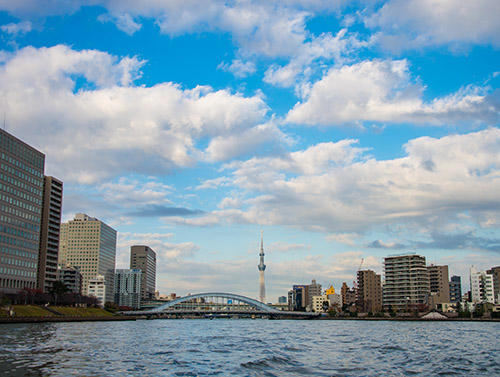
Edo is a water city and a prosperous town based on logistics by waterways. Currently, there are many major roads in Tokyo that were originally waterways. And in Chuo-ku, there are a number of active waterways, led by the Sumida River and Nihonbashi River. Let's go around there by boat! That's a boating tour. It's not just a boat play, but a journey through the Balibari arterial road where trade boats come and go until a little more than 100 years ago, the waterway that was the gateway. In addition to the remnants of Edo, there are many remains where the gorgeous Meiji Taisho era remains. You can see Are and Chore, which can not be seen from the ground, along with the guide's explanation.
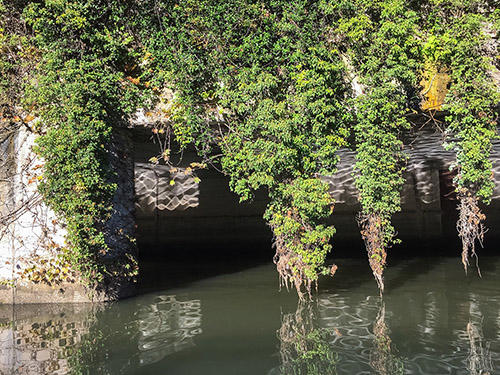 Is there anyone who knows where it is here?...!? (The hint is the site of a certain subway.) Is there anyone who knows where it is here?...!? (The hint is the site of a certain subway.)
Of course, I also go around the hot places now.
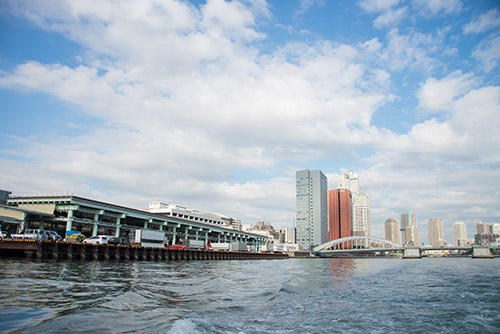
In Tsukiji Market...
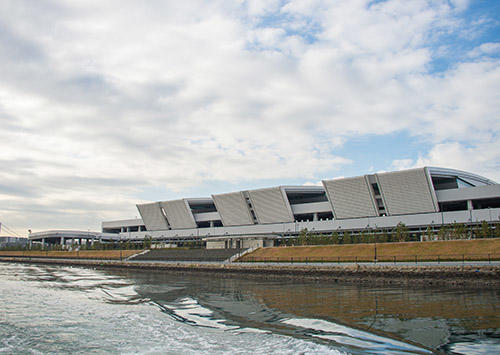
Toyosu planned site!
There are various types of tours, so you can choose what place, how much time, and how deep you want to see according to your preference. Each tour has a professional guide, so it's very interesting.
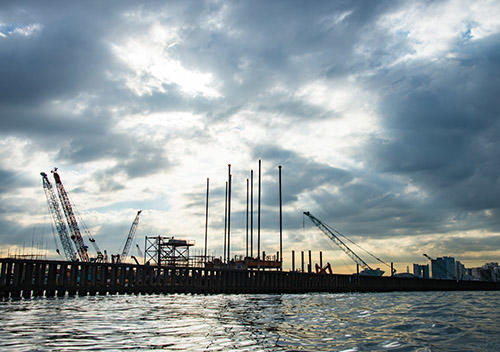 You can also see landfills under construction in Tokyo Bay. You can also see landfills under construction in Tokyo Bay.
The boating tour is not held in winter, so the next few months will be the on-season. At that time, a wide variety of tours are held. For more information, please visit our website.
→The Association for the Creation of Water City Tokyo
When you look at Tokyo in Heisei from a spacious waterway, you can see a completely different figure. I think you can also experience the people and things from Edo to the pre-war period, the flow of culture, and how to connect with neighboring areas such as Asakusa.
It is a very fulfilling event, so please come and visit Chuo-ku from the waterway in the coming warm season.
By the way...
This is for those who say, "I like bridges rather than rivers!"
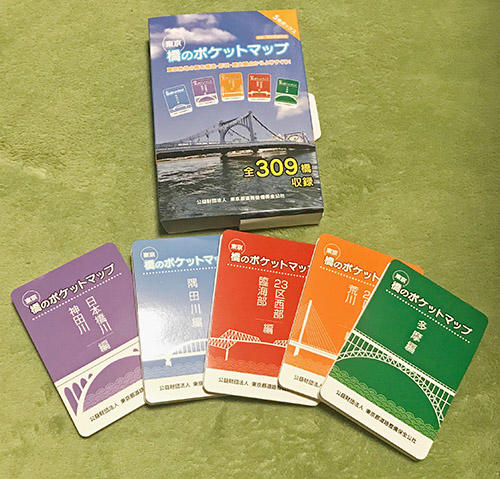 "Bridge Pocket Map" edited by the Tokyo Metropolitan Bureau of Construction. It is a wonderful book that covers major rivers and bridges in Tokyo. "Bridge Pocket Map" edited by the Tokyo Metropolitan Bureau of Construction. It is a wonderful book that covers major rivers and bridges in Tokyo.
It's like this when you open the inside.
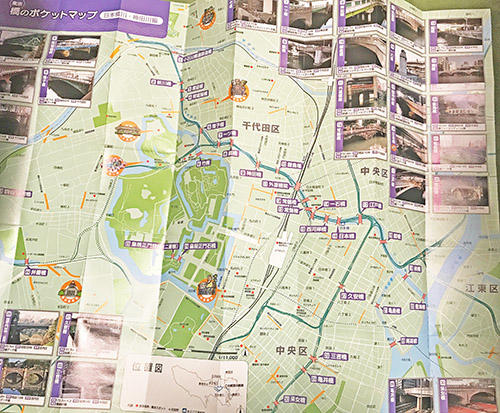 Each one is pocket-sized, 5 books in total. The price of the box set that contains all is 800 yen. It is also sold at the Kachidokibashi Museum, located at the base of Kachidokibashi. I don't really recommend these maps. Each one is pocket-sized, 5 books in total. The price of the box set that contains all is 800 yen. It is also sold at the Kachidokibashi Museum, located at the base of Kachidokibashi. I don't really recommend these maps.
Other areas| Event Information| Hundred Views of Chuo-ku| Ningyocho, Hamacho, Higashinihombashi area| Tsukuda, Tsukishima, Kachidoki and Harumi areas| Nihonbashi, Kyobashi and Yaesu areas| History, culture| Correspondent's recommended information| Tsukiji, Shintomi, Minato area| Kayabacho, Hatchobori, and Shinkawa areas
Page top▲
[CAM]
April 28, 2017 14:00
On April 26, the Yomiuri Shimbun Tokyo area reported about the rebuilding of the 47-year-old and aging Chuo-ku government office building. . In order to rebuild to the current address, it is necessary to move twice in conjunction with the relocation to the temporary government building, and the cost is high, so the plan to relocate to the current Brossam site is also influential. However, the current location is the historic site of the Tsukiji House of the Tosa Domain, and it is said that there are voices that will spare the relocation.
According to Monoshiri Encyclopedia, "This area was the place where the Tosa clan Yamauchi family worshiped in 1826 (1826), and there was a clan residence here. It is said that the Yamauchi family used it as a Nakayashiki or Shimoyashiki. Toyoshige Yamanouchi, the 15th generation of feudal lord during the late Tokugawa shogunate period, is known to have led the Meiji Restoration along with Satsuma and Choshu. It is said that Sakamoto Ryoma, the Shishi of late Tokugawa shogunate, went to a dojo in Sadakichi Chiba while staying at this clan residence. There is an explanation board next to the annex of Chuo-ku government office. "It is said.
[Shubo's Ten Hands]
April 26, 2017 18:00
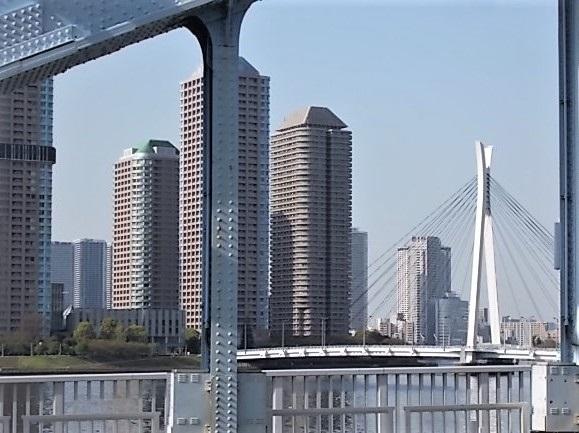
 Eitai Bridge was about 150 meters upstream from the location as of the Edo period. It is said to have been around 1698. At that time, it was painted in Ukiyo-e as a famous place with a good view on a large wooden bridge. Eitai Bridge was about 150 meters upstream from the location as of the Edo period. It is said to have been around 1698. At that time, it was painted in Ukiyo-e as a famous place with a good view on a large wooden bridge.
It is Japan's first road bridge made of steel. A tram was laid in 1904.
It was bridged with the 50-year-old celebration of the 5th Shogun Tsunayoshi. On August 19, 1807, the bridge collapsed due to congestion toward the festival of Fukagawa Hachiman, and more than 1,000 people drowning. There are so many stories about this accident. It is also known as a bridge that Ako Gishi crossed when he lifted from Kira's residence to Sengakuji Temple.
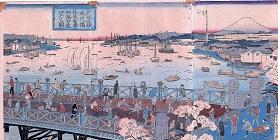
 Both the upper photo and the lower picture want the direction of Tsukuda Island. Both the upper photo and the lower picture want the direction of Tsukuda Island.
 The upper photo was taken from Eitai Bridge. The upper photo was taken from Eitai Bridge.
[Silver]
April 26, 2017 14:00
"madras", a luxury shoe store in Ginza 5-chome
The other day, when I passed in front of the store, I got  a leaflet called "The Origin of the madras name". a leaflet called "The Origin of the madras name".
It's not clear whether this shop or Washington shoe store was the first time I bought shoes in Ginza.
For more than 30 years, the name of this store has been questioning "Why is it the same as the name of the region in India ?" ?"
According to the explanation of the leaflet we received,
"The origin of the madras name:
The history of Madras' name goes back to 1946, when Italian Valentino Picolott founded the company alone.
His company has grown to be rewarded for many years of effort and to be recognized as one of the prominent shoe companies in the home of Italy.
The shoes that were produced in the early days were hand-sewn mochasin using high-quality kids. This high-quality material is tanned in Italy, but the raw material was available in the Madras region of India. It is said that the company name was given with respect and appreciation to Madras, the place where this high-quality leather is produced."
My long-standing question was resolved  and I was refreshed. I wish you all the best for Mr. Madras. and I was refreshed. I wish you all the best for Mr. Madras.
[Shubo's Ten Hands]
April 25, 2017 12:00

 Thirtyma moat trace Thirtyma moat trace  (the place with pink arrows) (the place with pink arrows)
 From Ginza, take Harumi-dori St. toward Tsukiji and just before Showa-dori. From Ginza, take Harumi-dori St. toward Tsukiji and just before Showa-dori.
The old map below was published in Kaei 2 (1849) (the place with a black arrow).
It is indigo on the left and right, and the one shown is Horikawa. The location of the two arrows is almost the same. When you walk around here, the road is booming.
It was connected from the Kyobashi River to the Shiodome River. In 1612, at the order of Tokugawa shogunate in Keicho 17 (1612), the Saikoku Daimyo excavated mainly for the purpose of boating. This name was given because the moat width was thirty (about 55 meters). In Bunsei 11 (1828), it was narrowed to nineteen. In 1952, the pile of rubble after Pacific War was reclaimed for processing. 
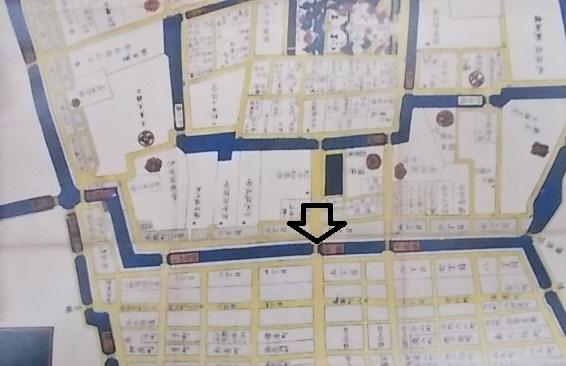
[O'age]
April 25, 2017 09:00
One corner of GSIX was a state where there were many people walking from the sidewalk of Chuo-dori to match the person in front, of course, the building was crowded and the escalator was riding in two rows. From the 6th floor to the 13th floor by elevator, and from the stairs, the shrine is located on the northeast side of the rooftop garden and you can visit it.
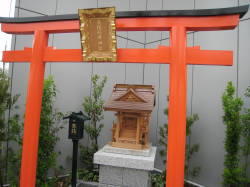 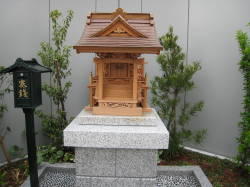
Kakugo Inari Shrine is one of the tours of Ginza Hatcho Shrine, and the explanation board of the local shrine has the following description.
I'm sorry
Yamago Shrine, which is now away, is now 150 years ago, and in 185, on the day of Nyorai, he is commissioned by Hongu in Fushimi, Fushimi, to serve Negishi in Edo. Since then, the people of the store have been deeply worshiped by the Edo citizen and have been the owner of the Edo store. One night in 1881, the grandfather of the shrine guardian recognized a white fox near the temple, but found that there was a volume of kakejiku's remains on the trace, and if he looked suspicious and looked into it, he would be in awe at the statue of Sanshu Toyokawadivine spirit. The shrine can be seen as a sacred selection and, especially as a god of fire prevention, saves the difficulties of local residents and reduces the number of people around the world. However, in September 1923, the Great Kanto Earthquake of September 1923, the Great Kanto Earthquake of March 1925, There is no doubt that it can be seen in a new homeshrine hall. On February 18th, 1929, Mimi's Spring February 18th, 1929, he asked Hie-jinja Shrine Miyaji to divide divine spirit and raise it on the roof of the main building, 80 feet above ground. April 15, 1965 Magazine Matsuzakaya Ginza Store
Next to it is an explanation board that the Matsuzakaya Ginza store was here. I feel lonely for a moment when I think it's no longer here.
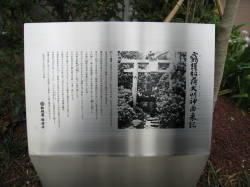 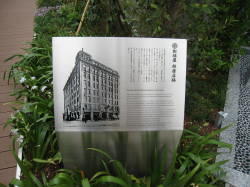
|
Links
|

 Is there anyone who knows where it is here?...!? (The hint is the site of a certain subway.)
Is there anyone who knows where it is here?...!? (The hint is the site of a certain subway.)

 You can also see landfills under construction in Tokyo Bay.
You can also see landfills under construction in Tokyo Bay. "Bridge Pocket Map" edited by the Tokyo Metropolitan Bureau of Construction. It is a wonderful book that covers major rivers and bridges in Tokyo.
"Bridge Pocket Map" edited by the Tokyo Metropolitan Bureau of Construction. It is a wonderful book that covers major rivers and bridges in Tokyo. Each one is pocket-sized, 5 books in total. The price of the box set that contains all is 800 yen. It is also sold at the Kachidokibashi Museum, located at the base of Kachidokibashi. I don't really recommend these maps.
Each one is pocket-sized, 5 books in total. The price of the box set that contains all is 800 yen. It is also sold at the Kachidokibashi Museum, located at the base of Kachidokibashi. I don't really recommend these maps.




